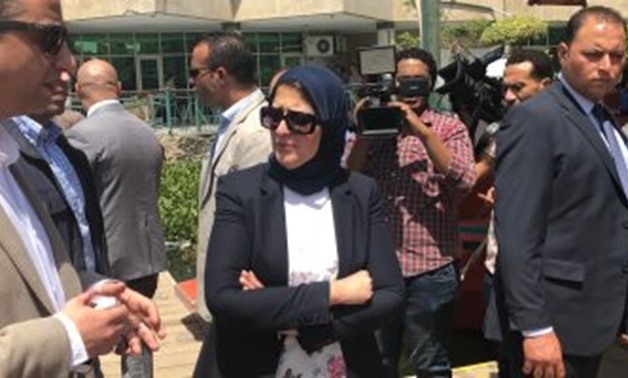
FILE - Minister of Health and Population Hala Zayed
CAIRO - 15 December 2018: On the sidelines of the inauguration of housing projects and water plants on Saturday by President Abdel Fatah al-Sisi, Minister of Health and Population Hala Zayed displayed the results of screening for hepatitis C and chronic diseases.
The minister added that citizens aged between 26 and 35 compose 60 percent of citizens who did the check-ups. The total number of citizens screened is 17,537, 323 with women composing the bigger portion of the turnout. The total number of citizens diagnosed with hepatitis C is 732, 732 and they started to receive treatment.
“Hepatitis C can spread from one patient to four or five people in his sphere. The direct cost per patient is LE50,000 and the same for the one who gets the contagion,” the minister highlighted adding that the direct cost is $700 million and can reach $3.5 billion.
Zayed stated that only 50 percent of citizens have health insurance.The minister added that local manufacturers have been supplying necessary equipment to the ministry which has reduced the cost.
The minister said that 84 percent of deaths are caused by chronic diseases. “When the household’s breadwinner gets ill, the children drop out of education. The productivity of the patient decreases,” Zayed explained.
The results of screening for chronic diseases identified 5,3 million diabetes patients, and 3.6 million hypertension patients. It is estimated that 21 percent of the population suffer from hypertension.
Moreover, the screening revealed that 877,000 citizens are at risk of becoming diabetes patients. Only 25 percent of screened citizens have normal weight as 36 percent are overweight, while 39 percent are obese summing up to 6.8 million.
The number of citizens screened in the first phase is 12.4 million, and in the second phase, the number is 5.1 million. The screening teams went to industrial complexes, public and private schools among others. Citizens can resort to call centers and social media to know the nearest screening points.
“In each phase, we ensure than there is fair geographic distribution among border, urban, and rural governorates,” the minister said.
The second phase that kicked off recently consists of 11 governorates including Red Sea, Sohag, Aswan, Cairo, South Sinai. In parallel, the third phase will kick off in January covering seven governorates to end in April. In each phase, there are permanent and mobile screening units distributed over 2,000 locations.
The minister said that the screening helped citizens to understand some basics regarding their health. “Some citizens got to understand the concept of ratio between height and weight,” Zayed clarified.
Zayed praised health workers involved in the screening campaign saying that “most of the campaign members are young and refuse to take holidays.” The screening teams include a physician or pharmacist, a nurse, and an employee that enters data. “Health workers affiliated with the WHO observe, follow-up with patents, and check results and data,” the minister stated.
Zayed stated that the average number of days a patient on a list waits for before receiving treatment dropped to 18 from 40. Most of those patients suffer from cardiovascular diseases caused by diabetes, hypertension, and obesity, she clarified.

Comments
Leave a Comment